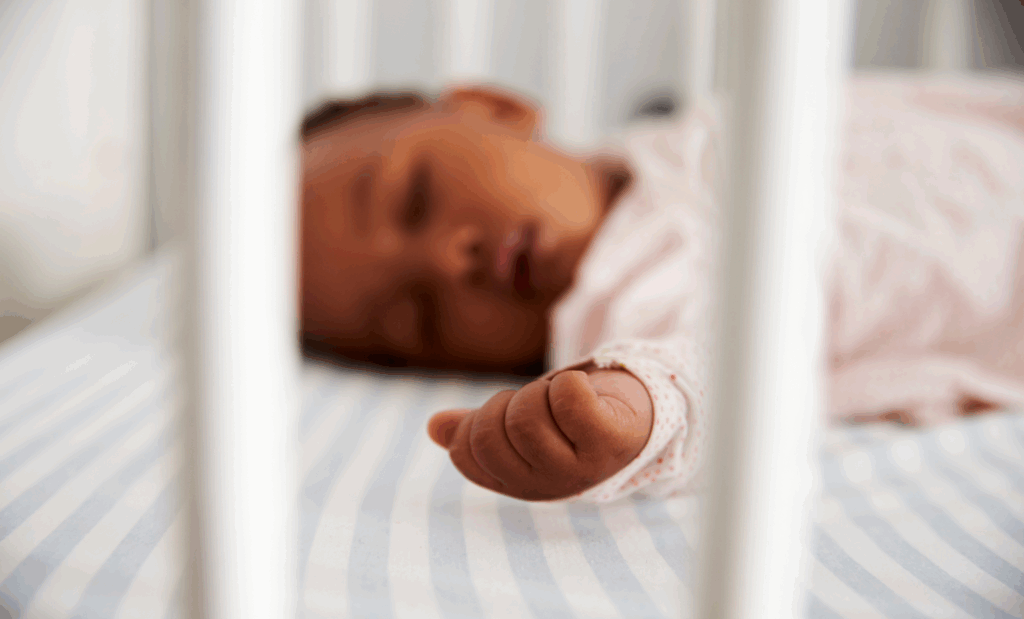Sudden Infant Death Syndrome (SIDS) is the unexpected death of a healthy infant, usually during sleep in the first year of life. Researchers believe a mix of biological and environmental factors may contribute.
While rare, SIDS is deeply concerning for parents, making it essential to follow safety guidelines and create a healthy sleep environment to help reduce the risk. Here’s what you need to know and how to lower your child’s risk.
Safe sleep practices
Creating safe sleep habits for your baby is an essential part of supporting their well-being. Start by placing your baby to sleep on their back every time — whether it’s for naps or nighttime rest. This simple practice is one of the most effective ways to lower the risk of SIDS.
“Babies should always sleep on a firm mattress covered with a tightly fitted sheet,” says Lilian McKinley, MD, a pediatrician at Mount Nittany Health. “Avoid soft surfaces like couches, armchairs or adult beds, as they can increase the risk of suffocation or entrapment.”
The baby’s sleepwear is another important consideration. Dress them in lightweight clothing appropriate for the room’s temperature, and avoid over-bundling or using infant hats when indoors. Overheating has been linked to an increased risk of sleep-related complications, so maintaining a comfortable environment is key.
“While swaddling can be helpful for newborns, make sure it’s done correctly to prevent loose fabric from obstructing their breathing,” says Dr. McKinley.
Use a safety-approved crib, bassinet or play yard designed specifically for infant sleep. Co-sleeping in the same bed is not recommended, but keeping your baby’s sleep space close to your own — such as a crib next to your bed — can provide convenience and reassurance while adhering to safety guidelines.
Creating a safe sleep environment
Designing a safe sleep environment for your baby involves thoughtful preparation to minimize risks and promote healthy rest. Begin by selecting a crib, bassinet or play yard that meets current safety standards.
“These products are specifically designed to provide a secure space for infants. Ensure the mattress fits snugly within the frame and is firm enough to support your baby without sinking,” says Dr. McKinley. “Use a tightly fitted sheet made for the crib’s dimensions, avoiding items like bumper pads, pillows or loose bedding. These items can pose potential hazards in the sleep space.”
Maintaining a comfortable room temperature is another key aspect. Babies should sleep in an area that isn’t too warm or too cold, as this helps prevent overheating. If you’re using a wearable blanket or sleep sack, choose one appropriate for the season to keep your baby cozy without excess layers.
Additionally, creating a smoke-free environment is critical for your baby’s health. Secondhand smoke has been associated with an increased risk of SIDS, making it essential to keep the sleeping area free from exposure.
Importance of routine check-ups
Regular visits to your baby’s pediatrician play a key role in supporting their healthy growth and development. These appointments provide an opportunity to address questions and concerns, including those related to sleep safety.
“Your pediatrician can guide you through best practices tailored to your baby’s unique needs, offering advice on topics like sleep positioning, appropriate sleepwear and creating a safe environment for rest,” says Dr. McKinley.
During these check-ups, your doctor will also monitor your baby’s development and overall health, ensuring they are meeting important milestones. If any potential concerns arise, they can be identified early and addressed promptly. These visits are not just for addressing immediate health issues — they’re also a chance to learn more about long-term strategies for keeping your baby healthy and safe.
Pediatricians can also provide valuable insights into creating a consistent routine that supports better sleep habits as your baby grows. Building this relationship with your child’s healthcare provider helps foster trust and confidence, giving you peace of mind as you navigate parenthood.
By staying informed and creating a safe sleep environment, you can take meaningful steps to reduce the risk of SIDS. Every effort counts when it comes to protecting your baby’s health and giving them the safest start in life.
Pediatrics
Discover more about Pediatrics, including locations and providers, at Mount Nittany Health



